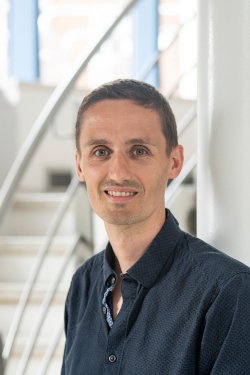Stephen Goldup
2020 United Kingdom Award Finalist — Faculty

Current Position:
Professor of Chemistry & Royal Society Wolfson Fellow
Institution:
University of Southampton
Discipline:
Synthetic Chemistry

Current Position:
Professor of Chemistry & Royal Society Wolfson Fellow
Institution:
University of Southampton
Discipline:
Synthetic Chemistry
Recognized for: The development of novel synthetic methods for the construction of interlocked molecules and applications thereof.
Areas of Research Interest and Expertise: Interlocked Molecules, Mechanical Bonds, Non-covalent Interactions, Mechanical Chirality, Synthetic Chemistry
Previous Positions:
MChem, Oxford University
PhD, Imperial College London (Advisor: Prof. A. G. M. Barret)
Senior Postdoctoral Fellow, The University of Edinburgh (Advisor: Prof. D. A. Leigh)
Leverhulme Trust Early Career Fellow, Queen Mary University of London
Senior Lecturer and Royal Society University Research Fellow, Queen Mary University of London
Associate Professor and Royal Society University Research Fellow, University of Southampton
Stephen Goldup, PhD, has made tremendous advances in the controlled synthesis and novel application of mechanically interlocked molecules (MIMs). MIMs are different from “normal” molecules because they are constructed by threading one molecule through a ring-shaped portion in another molecule. Two famous examples of MIMs are catenanes, which are ring-shaped molecules connected like links in a chain, and rotaxanes, which consist of molecular rings threaded along a dumbbell-shaped molecule. These arrangements allow the components to move freely relative to one another as there are no direct chemical bonds between them that would normally restrict such motions. As a result, MIMs have been investigated extensively as components of molecular machines. Goldup has demonstrated that rotaxanes can be useful as more than molecular curiosities. Specifically, by exploiting the unique structure of MIMs, he has shown that they can be capable of controlling chemical reactions and forming luminescent complexes for use in computer displays. Additionally, Goldup has pushed the field into uncharted territory by discovering synthetic routes to types of MIMs that were previously inaccessible. For example, he has developed an elegant solution to access types of chiral MIMs that were previously only available in minute quantities. Chiral molecules can exist in two mirror-image forms—much like our hands—that possess unique properties that can be exploited in catalysis, sensing, and materials science. Thanks to Goldup’s efforts to dramatically simplify the routes to this class of MIMs, researchers can now explore their applications in fields like medicinal chemistry, catalysis, sensing and fluorescent molecules for electronic displays.
"My research combines finding simple ways to make interlocked molecules that have been hard to synthesize before, with demonstrating their applications. My group and I are honored that our efforts have been recognized by this Blavatnik Award!"
Key Publications:
Other Honors:
| 2019 | Wolfson Fellowship, Royal Society |
| 2016 | Macrocyclic and Supramolecular Chemistry Discussion Group Bob Hay Lectureship, Royal Society of Chemistry |
| 2014 | Fellow of the Royal Society of Chemistry |
| 2014 | Hickinbottom Award, Royal Society of Chemistry 2012 Thieme Journal Chemistry Award |
In the Media:
Chemistry and Engineering News – Tying up Topological Chirality
Chemistry and Engineering News – Ramped-up Route to Polyrotaxanes
Chemistry World – Rotaxanes Make Symmetry History